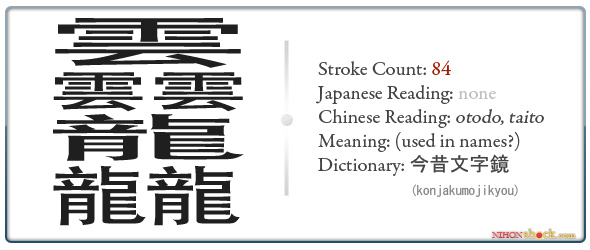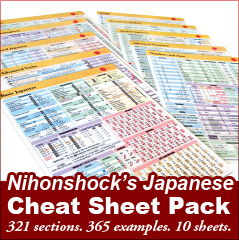Crazy kanji: what’s the highest stroke count?
Sooner or later every Japanese learner asks the question, which kanji has the highest stroke count?
Well, today I’m going to hopefully answer that question for everyone once and for all.
As a disclaimer, I’ll just say that the information in this article is largely based on what I found on the following two Japanese pages. I did however do some research of my own at the Nagoya City Library and found a few more noteworthy kanji that I will add to the tale.
The most strokes
In this article I will basically follow the same format as the articles I pointed to above which provided the bulk of the information I’m using. That is: we will start by looking at the Japanese elementary school 1st year kanji with the highest stroke and work our way up year by year, level by level and eventually dictionary by dictionary until we reach the top.
Elementary school year 1
mori
Stroke count: 12
The 1006 kanji Japanese children learn at elementary school are strictly regulated, so all students learn all kanji in the same order. Year one starts pretty easy, the kanji for forest takes #1 with a stroke count of 12. Not so bad when you consider you’re just putting 3 tree (
Elementary school year 2
kao – you
Stroke count: 18 each
In year 2 things have gotten quite a bit more difficult already. This year students will have to come to terms with two kanji that require a hefty 18 strokes to pen, and they’re a quite a bit more complicated than putting three identical characters together.
Elementary school year 3
dai
Stroke count: 18
Another 18 stoke kanji takes the crown in the 3rd year of elementary school.
Elementary school year 4
kyou – gi
Stroke count: 20 each
4th grade ups the top count to 20 strokes, with a tie for first place.
Elementary school year 5
go/mamo.ru
Stroke count: 20
Year 5 keeps chugging along with another 20 stroke champion.
Elementary school year 6
kei – zou
Stroke count: 19 each
Year 6 students can take a bit of a breather since they’ll only have to work with this pair of 19-strokers. But they can’t breathe for long since things are going to get harder real soon.
Secondary education level
While there are strict rules for the kanji that Japanese students learn in elementary school (
Kanjikentei level 4
kan
Stroke count: 23
A mighty debut into the realm of 20+ kanji, this is where you’ve got to make sure your thinking cap is on right. This character means “mirror” or “to look back”
Level 4 of the Kanken covers approximately 1300 characters.
Kanjikentei Level 3
ko – oni
Stroke count: 21 each
A couple steps back in stroke count though not necessarily in difficulty. Although you’ve probably only come across 顧, which means “to reflect” or “to observe“, if you’ve been studying the language for a while,
Level 3 of the Kanken covers approximately 1600 characters.
Kanjikentei Level 2
kan
Stroke count: 21
Keeping the same stroke count as the previous kanken level, this kanji refers to a large military ship or battleship.
Jouyou kanji
Level 2 of the kanjikentei examination marks the completion of the widely recognized Jouyou kanji, which total 1945 characters altogether. Thus, weighing in at 23 dashes of ink,
Characters for use in names
taka – rin
Stroke count: 24 each
In addition to the Jouyou Kanji, Level 2 of the kanken also requires knowledge of the 983 (until recently there were only 285) kanji officially recognized for use in names . The highest stroke counts in this group are
Jouyou kanji (including old forms)
chou
Stroke count: 25
Many kanji used today are simplified versions of more difficult kanji that were used up until the end of World War II. If we include the old versions for these characters, the new leader of the Joyo kanji becomes
Kanjikentei level semi-1
utsu
Stroke count: 29
Moving up to the 2nd highest level of the Kanjikentei, we are now in the realm of what a highly educated adult Japanese can read (but probably not write).
JIS 0208 Kanji
hyou – ran
Stroke count: 30
JIS 0208 (Japanese Industrial Standards) specifies 6355 kanji for “exhange of information.” This specification is the what Japanese character sets in computers are based on (more or less).
One of these characters is 驫, which is comprised of three horse characters and means–not surprisingly–many horses. Apparently there’s an unstaffed train station in Aomori prefecture where you can find this character. The station is named
鸞 is slightly less obscure. It’s found in the name of the founder of the Joudo Shinshuu (pure land) sect of Buddhism. Shinran (
Kanjikentei level 1
so / ara.i
Stroke count: 33
Kanjikentei Level 1 is the holy grail for kanji lovers. It covers every kanji you will ever need to know and far too many more that you won’t. It also requires you to know highly obscure readings for all the kanji which you oh-so-mistakenly thought were easy (ie. Did you know that
With a 14% success rate even among actively studying, intelligent, adult Japanese applicants, there is no higher honor of nerdiness to be bestowed than to pass this test. And the highest stroke count you’ll find here is a dazzling 33 strokes, made up of 3 characters for deer pushed together. It means “rough” and is typically simplified to just one deer character when it is actually used (it appears in some 4-character compounds).
Note: This character is included in the JIS 0212 kanji set (less widely supported than JIS 0208).
The Twilight Zone
To the best of my knowledge, the 33 stroke 麤 is the highest stroke count that can be rendered on (most) computers (it’s in the MS Gothic font with Windows XP and higher, and perhaps earlier versions too). But wouldn’t it be all too easy if kanji stopped there. No, no my friend, it does not. This is actually where the real stroke count games begin.
Once you’ve mentally prepared yourself for the carnage of ink on paper you’re about to witness, scroll over these images I’ve prepared (computer fonts as far as I know don’t include these characters and if they do the display will be unreliable) and gaze in awe at the top stroke count kanji from the major Japanese kanji dictionaries. Remember that these are each intended to be a single character only, that is… written between two lines on a sheet of paper.
Monsters, aren’t they? Okay, now it’s time to look at the big daddy of all dictionaries. The
How many kanji do you learn each week at university? 10? Let’s say 20. At 20 kanji a week… you would need 50 years to learn all of these kanji. And that’s without summer vacations.
But I digress, there’s no reason to waste your life learning kanji that nobody knows when somebody has already written the dictionary for you. Let’s just look at the highlights, shall we?
So in the daikanwajiten, the mother of all kanji dictionaries, there is a tie for 1st place. How are we to resolve this dilemma?
But wait, there is another. That’s right, a kanji that’s not in the daikanwa. And for that matter, a kanji that’s not even in any historical Chinese records.
Behold….!
According to a 2002 newspaper article from Kumamoto, somebody in Japan was apparently using this as their personal name as recently as the 1960s. The kanji has been included in the most comprehensive computer-based dictionary software available (the konjyakumojikyou).
Otodo has made several appearances on Japanese variety TV shows, where Japanese ooh and aah at how “difficult” it is, but really this kanji is just a pain in the a#$. You write cloud three times and under it you write dragon three times. When you’re done your hands and eyes hurt and you’ve got what’s basically a black spot on a piece of paper.
Personally, I don’t think this is even a legitimate kanji. It was probably some guy’s idea of a joke, and because of one loser’s strange sense of humor now everyone wants to rewrite history. Kind of an anticlimax, really. But, despite its origin, it’s gained a place in history and so in a sense it has become a real kanji.
The nihonshock award for most strokes goes to…
Now I get to add my two cents on the issue. Take a look at the 84 stroke kanji again. Yeah that’s a lot of strokes, but what we’ve really just done is written cloud and dragon three times each and called it one kanji. The number of unique strokes or the number of strokes that you actually need to know in order to write the character is actually just 28 (
The same goes for both 64 stroke kanji from the daikanwa, and the 52 stroke from the koukanwa and the 48 stroke from the koukijiten. They’re all just pushing clouds and thunder and dragons together and calling it a character. Hogwash, I say!
I don’t know what the Japanese think but I call that cheating. So I opened up the daikanwa myself and found the character with the most unique strokes.
And the winner is….!!!
Congratulations to sei! Now that’s what I call a kanji.
However, I have to admit that even this method ended in a tie, because there was another 44 character kanji in the daikanwa which met the requirement of having entirely unique parts. A (small) round of applause for the runner up, please!
Why runner up? Well, look at it. It’s lots of strokes, but the right half is like the other disqualified kanji, just sticking easier ones together. The only difference is it’s squishing different kanji together instead of multiplying the same one. Boo! The bottom left is a triple wing (unique, but hardly difficult). Really the only trick to this kanji is remembering that top left bit.
Other people may have their opinions and research on which kanji is really #1 and I welcome all comments. There’s a lot of information in this article so I probably made some mistakes even. Let me know if you spot anything.
On a final note I just want to say that for a variety of reasons, stroke count and difficulty are not the same thing. Not even close. But since there’s no way to really measure how difficult a kanji is, I’ll probably never get around to writing that article.
Supplement
Just for kicks, here’s a short list of some words that look really hard, but which Japanese people read all the time (just don’t ask them to write it).
画数 多 漢字
| KANJI | MEANING |
(bara) |
rose |
(kirei) |
beautiful |
(chuucho) |
hesitation |
(moura) |
coverage, inclusion |
(shuushoku) |
job searching |
(keiren) |
a spasm, seizure |
(rousoku) |
a candle |


















Story added…
Your story has been featured on Japundit!
Here is the link: http://www.japundit.com/Education/Crazy_kanji_whats_the_highest_stroke_count…